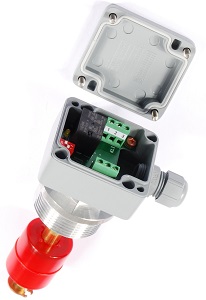- Pump control to fill and drain tanks and machinery
- The fixed or selected level switching points (min/max) of the user will be switched on or off by a relay located in the housing
- The device is adjustable through the terminal box.
- The MNS control system is available for all Engler float switches with terminal box
MNS-

A float switch with level control is a sensor typically used in tanks or containers to monitor liquid levels and perform corresponding control tasks.
Operating Principle
The operating principle of a float switch based on a reed contact relies on the use of a reed contact as a switching element. A float switch consists of a buoyant body, also known as a float, which floats on the liquid surface. The buoyant body is equipped with a magnet. As the liquid level changes, the buoyant body moves up or down accordingly. When it reaches a certain fill level, the magnet approaches the reed contact. The reed contact consists of two ferromagnetic contact blades placed within a glass housing, separated by a small air gap. When the buoyant body's magnet reaches the reed contact, the magnetic field attracts the ferromagnetic blades, bringing them together. This action closes the contact blades, completing an electrical circuit. This closed circuit can be used to send a signal, such as triggering an alarm or controlling a motor.
Level control refers to the function of the float switch to maintain the liquid level within a certain range or trigger specific actions when the level reaches certain thresholds.
Advantages
- Simple and Robust Construction: Float switches have a relatively simple construction and are mechanically robust, making them durable and reliable for various environments and applications.
- Automation: Level control with float switches enables process automation. When the float reaches a predefined threshold, pumps, valves, or other devices can be automatically turned on or off to regulate the liquid level without requiring human intervention.
- Cost Efficiency: Float switches are comparatively cost-effective in terms of acquisition and installation, making them an economical solution for liquid level control.
- Versatile Applications: Float switches with level control can be used with a variety of liquids, regardless of their composition, making them suitable for different industries and applications, whether it's water, oil, chemical liquids, or other substances.
- Low Maintenance: The simple mechanical components of float switches typically require minimal maintenance, reducing operating costs and improving system reliability.
- Safety: Precise control of the liquid level with float switches can prevent accidents like overflow or dry running, enhancing the safety of facilities and processes.
- Environmental Friendliness: Automating liquid level control with float switches can help optimize the consumption of resources such as water or fuel, enabling more environmentally friendly processes.
- Flexibility: Float switches can be manufactured in various shapes and sizes to meet the specific requirements of an application. They are generally adaptable and can be easily integrated into existing systems.
Application Examples
Water Supply
In a water tank, a float switch with level control is used to monitor the water level. When the water level falls below a certain minimum value, the pump is automatically turned on to refill the tank. When the water level reaches the maximum value, the pump is turned off to prevent overflow.
Wastewater Treatment
In a wastewater treatment plant, level control is used to monitor the fill level in a sewage pit. When the level reaches a specific point, the control system can initiate a drainage process to discharge the wastewater.
Industrial Applications
In industrial processes where liquids are stored in tanks or containers, level control can be employed to monitor the liquid level and control pumps, valves, or other devices to regulate the liquid level.

